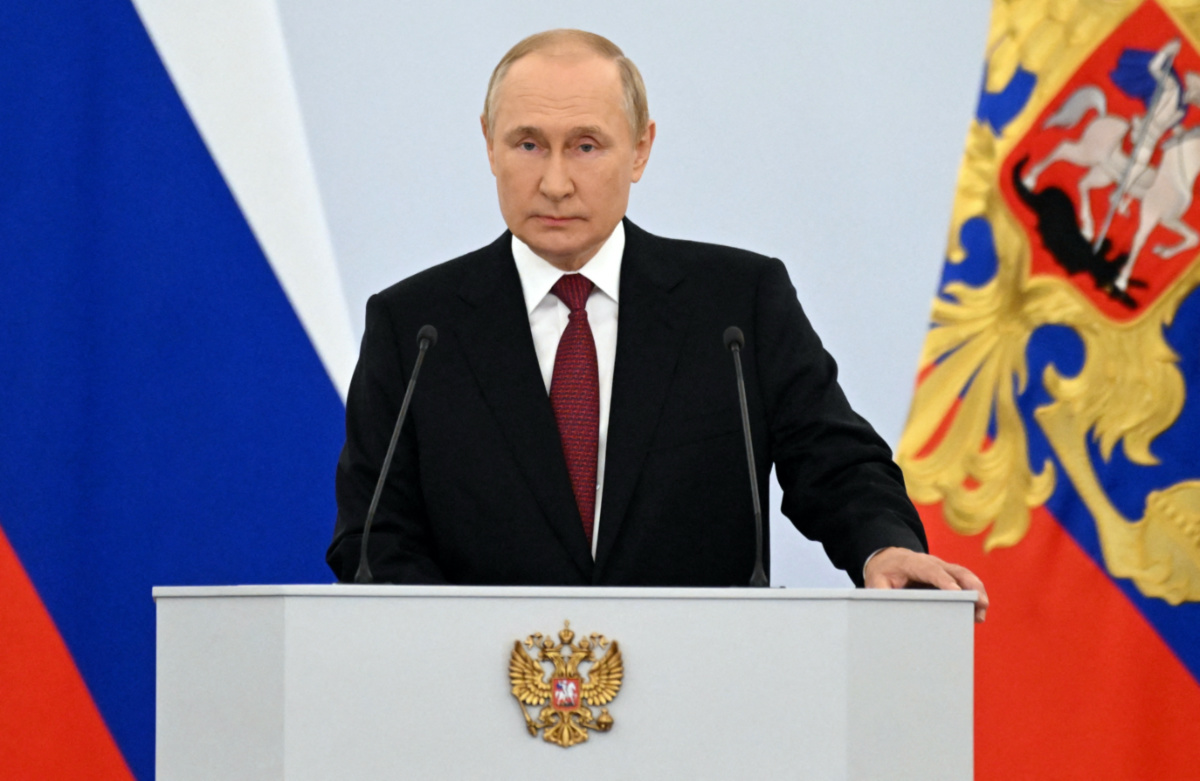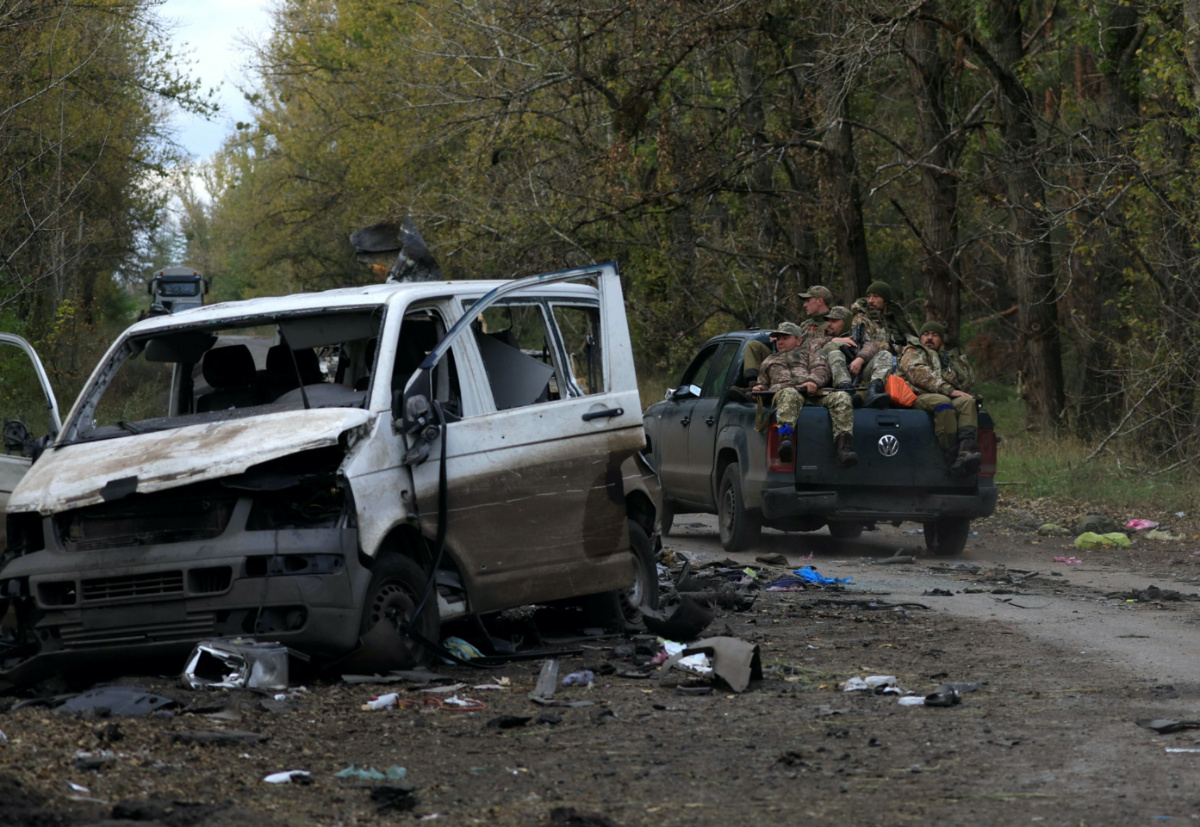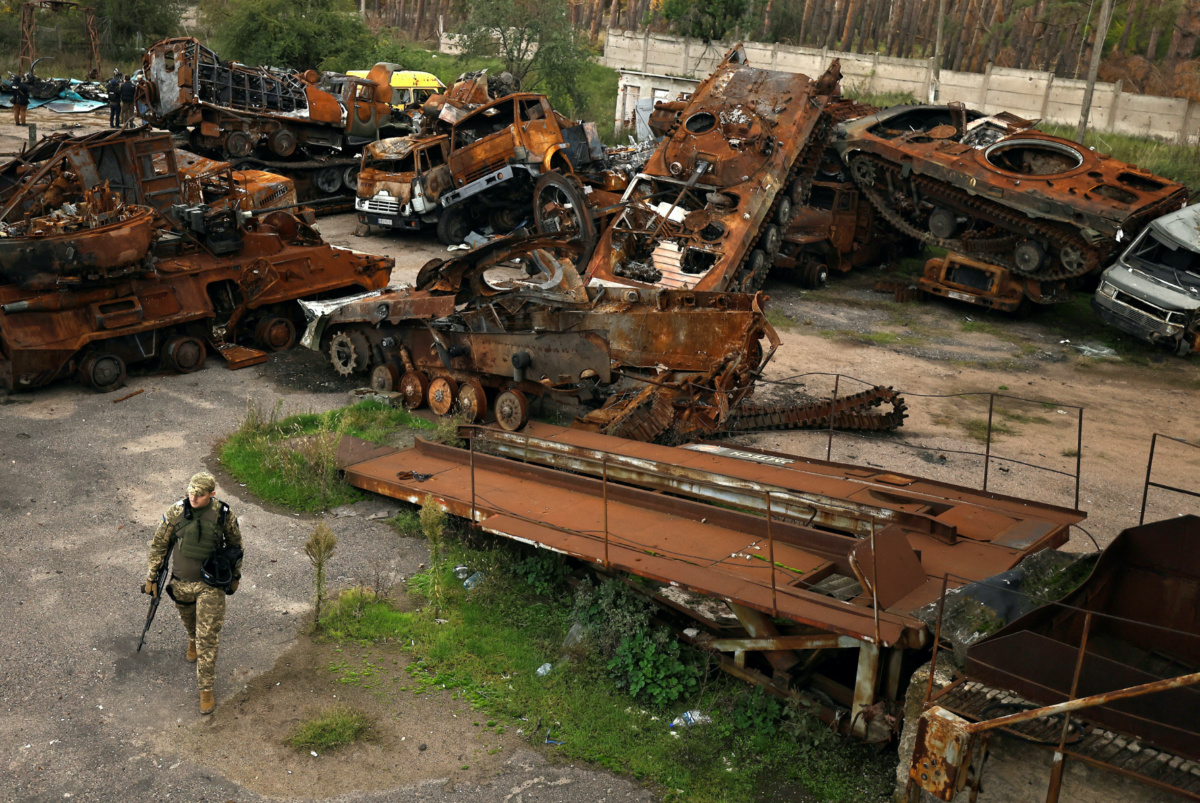Lyman/Bila Tserkva, Ukraine
Reuters
President Vladimir Putin signed a law to incorporate four partially occupied Ukrainian regions into Russia on Wednesday, in what Kyiv called the act of a “collective madhouse” at a time when Russia’s forces have been fleeing from the front lines.
The new law would incorporate around 18 per cent of Ukraine’s territory into Russia, equivalent to the area of Portugal, in Europe’s biggest annexation since World War II.

Russian President Vladimir Putin attends a ceremony to declare the annexation of the Russian-controlled territories of four Ukraine’s Donetsk, Luhansk, Kherson and Zaporizhzhia regions, after holding what Russian authorities called referendums in the occupied areas of Ukraine that were condemned by Kyiv and governments worldwide, in the Georgievsky Hall of the Great Kremlin Palace in Moscow, Russia, on 30th September. PICTURE: Sputnik/Grigory Sysoyev/Pool via Reuters/File photo.
Russia does not fully control any of the four provinces it claims to have annexed, however, and Moscow has yet to demarcate what it now asserts to be Russia’s new borders.
Ukrainian forces have recaptured thousands of square miles of territory since the start of September, including dozens of settlements in just the past few days.
A map of Russia’s “new regions” published by state news agency RIA included the full territory of the Ukrainian provinces, but some parts were shaded and labelled as being under Ukrainian military control.
“They will be with Russia forever,” Kremlin spokesman Dmitry Peskov said of the new regions, adding that settlements recaptured by Ukraine in recent days “will be returned”.
Russia announced the annexation of Donetsk, Luhansk, Kherson and Zaporizhzhia provinces after staging referendums that Kyiv and the West say were phoney exercises held at gunpoint. Kyiv says it will never accept the illegal seizure of its territory by force.
Serhiy Gaidai, the Governor of Luhansk, told national television that pro-Kyiv forces had liberated six villages in his region on Wednesday. He declined to give details.
Bodies in trees
The Russian moves come as momentum in the war has clearly swung in Ukraine’s favour since the start of September.
Thousands of Russian troops fled their positions after the front line crumbled, first in the northeast, and, since the start of this week, also in the south.
“Worthless decisions by a terrorist country are not worth the paper they are signed on,” Andriy Yermak, head of Ukraine’s presidential office, said on Telegram of the annexation moves, which he said reminded him of a “collective madhouse”.
Putin celebrated the annexations in a ceremony in the Kremlin followed by a concert on Red Square last week, only hours before Ukrainian forces captured Lyman, Russia’s main bastion in the northern part of Donetsk in the east.
On Wednesday, the bodies of two Russian soldiers were still lying bloating in trees on opposite sides of the road near Lyman, close to the blasted hulks of cars and a van.

Ukrainian army soldiers drive past a blasted white van in which, according to Ukrainian military officers, last weekend a Russian army unit was speeding in retreat toward the eastern town of Lyman, as Russia’s attack on Ukraine continues, outside the recently liberated town of Lyman, Donetsk region, Ukraine, on 5th October. PICTURE: Reuters/Zohra Bensemra
Occasional crumps echoed from distant fighting between retreating Russians and Ukrainian troops advancing toward a north-south highway that serves as one of the last supply routes for Russian forces in Luhansk province.
In Lyman, Nina, 73, stood by vans waiting for humanitarian handouts by the municipal building. There were 15 dead bodies of Russian soldiers lying in her street, she said.
“Nobody touches them,” she said. “Nobody removes them. It’s the fifth day they are lying there. And we have the smell. Is that right?”
Ukraine has so far given few details of its most recent military gains, in line with a policy of withholding comment about advances while they are under way.
In the south, its forces have been advancing since Sunday along the west bank of the Dnipro River, aiming to cut off thousands of Russian troops from resupply or escape.
“This week alone, since the Russian pseudo-referendum, dozens of population centres have been liberated. These are in Kherson, Kharkiv, Luhansk and Donetsk regions all together,” President Volodymyr Zelenskiy said in his nightly address on Tuesday.
We rely on our readers to fund Sight's work - become a financial supporter today!
For more information, head to our Subscriber's page.
Power station
Putin said Russia would stabilise the situation in the four provinces. In one of his first moves to assert his rule over them, he ordered the Russian state to seize control of Europe’s biggest nuclear power station, still run by Ukrainian engineers despite being captured early in the war by Russian troops.
The UN nuclear watchdog, the IAEA, said it had learned of plans to restart one reactor at the plant, where all six reactors have been shut down for weeks.
The power station is located right on the front line, on a Russian-controlled bank of a giant reservoir with Ukrainian forces on the opposite bank, and both sides have warned of the danger of a nuclear disaster from fighting near it.
In recent days, Russia detained the Ukrainian manager in charge of the plant. He has since been released but will not return to work. The head of Ukraine’s state nuclear energy company Energoatom, Petro Kotin, said he was now taking charge of the plant and urged workers not to sign any documents with its Russian occupiers.
Kyiv has long accused Moscow of planning to switch the plant from Ukraine’s power grid to Russia’s, a move it says would heighten the risk of an accident.
IAEA head Rafael Grossi, who is due to visit Kyiv and Moscow this week, posted on Twitter a picture of himself boarding a train for Kyiv and said negotiations on a safe zone around the plant were more important than ever.

A view of destroyed Russian tanks and armoured vehicles, amid Russia’s invasion of Ukraine, in the recently liberated town of Lyman, Donesk region, Ukraine, on 5th October. PICTURE: Reuters/Zohra Bensemra
Drone attacks
Even as Russian forces have been pushed back on the battlefield, Moscow has been launching attacks far from the front using what Kyiv says are Iranian-made drones since last month. Tehran has denied supplying them; Moscow has not commented.
Dozens of firefighters rushed to douse blazes on Wednesday in Bila Tserkva, around 75 kilometres south of Kyiv, following what Ukrainian officials said were the first strikes using the Iranian “loitering munitions” so close to the capital.
“There was a roaring noise, a piercing sound. I heard the first strike, the second I saw and heard. There was a roar and then ‘boom’ followed by an explosion,” said 80-year-old Volodymyr, who lives across the street.
“It is beyond me what those Russians think. I do not know when we will manage to chase them from our territory. It is just tears and heartache for my Ukraine. That’s all I can say,” said 74-year-old Lyudmyla Rachevska.
– With reporting by Reuters bureaux






